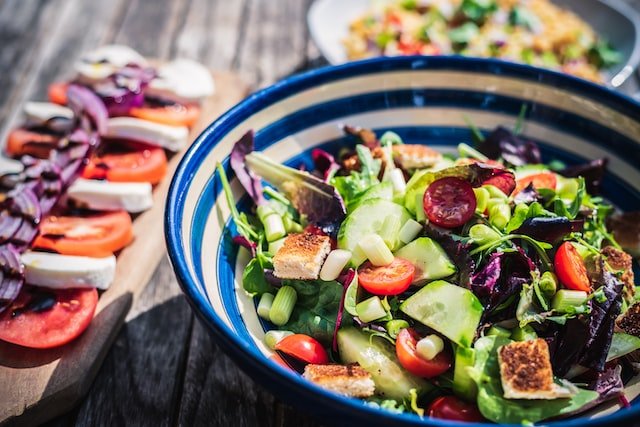Sitting down to lunch or dinner in Italy presents a unique challenge: namely, narrowing down the list of incredible options and choosing from a wide range of menus. For devotees of food tourism, we propose a journey through the Mediterranean dishes of Italy. But what do we mean when we talk about Mediterranean cuisine?
Table of Contents
How to get ahead in the Med
It’s wildly popular; healthy; and is the focus of multiple food tours in Italy. But what makes Mediterranean food so unique?
So-called “local cuisine” typically refers to one specific country, but Mediterranean cuisine pertains to the geographical area surrounding the Mediterranean Sea – including France, Portugal, Italy, Spain and Greece, among others. The recipes vary from country to country, but some characteristics are ever-present. The region’s sunny weather makes it ideal for agriculture, and the diversity of vegetables and spices at the diet’s core. Tomatoes, onions, lettuce, mushrooms, and cucumbers all feature heavily, whether fresh, baked, or grilled.
Olive oil is one of the main elements of this culinary blueprint, and its particular taste and aroma infuses virtually every Mediterranean recipe. The humble grape is ever-present too, used to make wine which is served individually and used in all sorts of local recipes. The region is also a hotbed for herbs and spices, with mint, oregano, basil, saffron, cilantro and garlic used abundantly.
Seeds and nuts are plentiful, from almonds to pistachio nuts, hazelnuts, pine nuts, and cashews. Wheat is one of the Mediterranean region’s essential elements, with bread and pasta never far from the dinner table. In addition, the proximity of the sea gives rise to a huge variety of fish and serving suggestions; and when it comes to meat, the region offers an abundance of chicken, pigs, sheep and goats.
Following this brief summary of Mediterranean cuisine, let’s look at some of the typical dishes which you should definitely try while visiting, or taking part in food tours in Italy!

Risotto
Start by cooking rice and stirring in broth until it becomes creamy. Then, mix in butter and onions; wine and cheese are optional, but always a welcome addition. From this starting point, there’s an entire universe of options when it comes to risotto. Serve with saffron, and you’ve got Risotto Alla Milanese. Cook it with cuttlefish and its ink: Risotto Al Nero Di Sepia. Try it with pancetta and peas: Risi E Bisi. Risotto can also be prepared using mushrooms, shrimp, and all kinds of vegetables. Some of the finest examples of this classic dish can be sampled at Mimi e Coco, Osteria Barberini, or Sofia.
Pizza
You’re no doubt already aware of the many different ways in which pizza can be served. So let’s focus primarily on Neapolitan and Sicilian pizzas, which are a staple of the Mediterranean diet. Pizza Napoletana consists of mozzarella and fresh tomato sauce, and plenty of it, with no other toppings other than basil and olive oil. On the other hand, Sicilian pizza (also referred to as “sfincione”, or “thick sponge”) has a thick crust, sauce made from tomato, onions, and herbs and an anchovy topping. Unlike the traditional round pizza, sfincione is often cooked in square trays. Try it for yourself at Ai Marmi, Il Pizzaiolo del Presidente, Mamma Rosa, or L’Antica Pizzeria da Michele.
Pasta
No pasta, no Italy – it’s as simple as that! The Mediterranean take on this highly traditional dish adds new elements to the typical spaghetti al dente base – don’t forget the olive oil… Extra toppings of shrimp or chicken go well with garlic, while veggie options include sun-dried tomato pasta and caprese (with fresh cherry tomatoes, cheese, and optional mushrooms). If you want to go fully local, try the Pasta alla Puttanesca, which blends together garlic, pepper, tomato, capers, anchovies and – occasionally – tuna. Taste these refreshing variations of the pasta you know and love at Tonnarello and La Tavernaccia, among others.
Tiramisu
When it comes to desserts, it does not get any more Italian than this. Coffee-soaked ladyfinger sponge is covered with mascarpone and egg cream, and topped with powdered cacao- with a dash of liqueur for effect. The traditional recipe is often enhanced with almonds or pistachio nuts. This mouth-watering dessert can be sampled at Nannarella, Mr. 100 Tiramisu, Tonnarello, or Otello.
Almond biscotti (Cantucci Toscani)
This is the perfect companion for your coffee. It translates loosely to “twice cooked”, because once it’s taken out of the oven, the biscotti is sliced and baked again. This means they can be stored for long periods of time. These thin, dry, crunchy treats are prepared with almonds, flour, sugar, eggs, and vanilla, with optional butter or oil. They are typically dipped in a dessert wine called Vin Santo. Varieties of this recipe include hazelnut or aniseed, and sometimes even pistachio nuts.
These are just some of the typical Mediterranean dishes to look out for – not to mention the different varieties that can be found on each region’s menus. Local chefs will be sure to add their unique touch to these well-known culinary staples. Don’t miss out!










